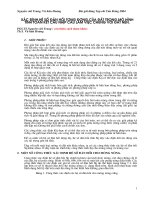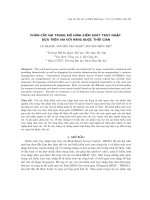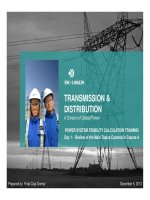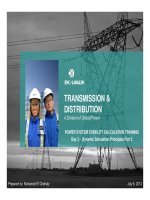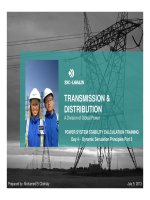Phần 5 KHÓA ĐÀO TẠO TÍNH TOÁN ỔN ĐỊNH VÀ ỨNG DỤNG TRÊN PHẦN MỀM PSSE CHO KỸ SƯ HỆ THỐNG ĐIỆN (Lựa chọn bộ kích từ trong mô phỏng ổn định và mô hình kích từ trên Phần mềm PSSE)
Bạn đang xem bản rút gọn của tài liệu. Xem và tải ngay bản đầy đủ của tài liệu tại đây (3.75 MB, 125 trang )
TRANSMISSION &
DISTRIBUTION
A Division of Global Power
POWER SYSTEM STABILITY CALCULATION TRAINING
D2
Sl ti fE it
D
ay
2
-
S
e
l
ec
ti
on o
f
E
xc
it
ers
November 19, 2013Prepared by: Mohamed El Chehaly
eBook for You
OUTLINE
2
OUTLINE
• Types of Exciters
• Exciter Models in PSS®E
• Identification of Typical Exciters
eBook for You
3
TYPES OF EXCITERS
TYPES
OF
EXCITERS
eBook for You
Introduction
4
TYPES OF EXCITERS
Introduction
Important to model excitation system of
titl ill
genera
t
ors as
it
p
l
ays a cruc
i
a
l
ro
l
e
during fast disturbances (first 10
seconds)
seconds)
Functions of an excitation system:
To provide
direct current
to the synchronous
To
provide
direct
current
to
the
synchronous
generator field winding
To perform control and protective functions
essential to the satisfactory operation of the
power system
To meet the specified requirements for operating
To
meet
the
specified
requirements
for
operating
flexibility
eBook for You
Introduction
5
TYPES OF EXCITERS
Introduction
Performance requirements:
Generator considerations:
Supply and adjust field current as the generator output
varies within its continuous capability
varies
within
its
continuous
capability
Respond to transient disturbances in order to prevent
damage of the generator such as:
Rotor insulation failure due to high field voltage
Rotor
insulation
failure
due
to
high
field
voltage
Rotor heating due to high field current
Stator heating due to high VAR loading
Ptidti
P
ower sys
t
em cons
id
era
ti
ons:
Contribute to effective control of system voltage
Improve system stability with fast response
Improve
system
stability
with
fast
response
eBook for You
Principle Scheme of Excitation
6
TYPES OF EXCITERS
Principle
Scheme
of
Excitation
eBook for You
Principle Scheme of Excitation
7
TYPES OF EXCITERS
Principle
Scheme
of
Excitation
Exciter
Provides DC power to the generator field winding
Regulator
Processes and amplifies input control signals to a
level and form appropriate for control of the
exciter
exciter
Terminal voltage transducer and load
compensator
compensator
Senses generator terminal voltage, rectifies and
filters it to DC quantity and compares with a
reference
eBook for You
Principle Scheme of Excitation
8
TYPES OF EXCITERS
Principle
Scheme
of
Excitation
Power system stabilizer
Provides additional in
p
ut si
g
nal to the re
g
ulator to
pg g
damp power system oscillations
Limiters and protective circuits
Wide array of control and protective functions
which ensure that the capability limits of the
exciter and the generator are not exceeded
exciter
and
the
generator
are
not
exceeded
eBook for You
Types of Excitation Systems
9
TYPES OF EXCITERS
Types
of
Excitation
Systems
DC excitation systems
Utilize a direct current generator with a
commutator as the source of excitation system
p
owe
r
p
AC excitation systems
Use an alternator and either a stationar
y
or
y
rotating rectifiers to produce the DC current
needed for the synchronous machine field
ST excitation systems
Excitation power is supplied through transformers
Excitation
power
is
supplied
through
transformers
or auxiliary generator windings and rectifiers
eBook for You
DC Excitation Systems
10
TYPES OF EXCITERS
DC
Excitation
Systems
Utilize DC generators as source of power
Represent early systems (from 1920s to
mid 1960s)
S d db AC dST it
S
uperse
d
e
d
b
y
AC
an
d
ST
exc
it
ers
Many are still in service and therefore
itb dld
requ
i
re
t
o
b
e mo
d
e
l
e
d
eBook for You
DC Excitation Systems
11
TYPES OF EXCITERS
DC
Excitation
Systems
Advantages
Less dependent on voltage oscillations
Require a small transformer
Drawbacks
Very slow response time
Small amplification of control signals
Uf
li i
d
tt
hi h i
U
se o
f
s
li
pr
i
ngs an
d
commu
t
a
t
o
r
w
hi
c
h
requ
i
re
maintenance
eBook for You
DC Excitation Systems
12
TYPES OF EXCITERS
DC
Excitation
Systems
IEEE recommended excitation system
IEEE
recommended
excitation
system
models represent the exciter by the
following block diagram and nonlinear
function S
e
eBook for You
DC Excitation Systems
13
TYPES OF EXCITERS
DC
Excitation
Systems
The saturation function S
is a design
The
saturation
function
S
e
is
a
design
characteristic of the exciter and is
specified by the two values S
e
(E
1
) and
e
1
S
e
(E
2
)
eBook for You
DC Excitation Systems
14
TYPES OF EXCITERS
DC
Excitation
Systems
The field voltage values E
1
and E
2
should
The
field
voltage
values
E
1
and
E
2
should
normally be chosen near the knee of the
exciter’s magnetization curve and near
the exciter ceiling
eBook for You
DC Excitation Systems
15
TYPES OF EXCITERS
DC
Excitation
Systems
Amplifiers
Amplifiers
In order to automatically control the terminal
voltage of the machine, a transducer voltage
must be compared to a reference voltage and
amplified to produce the exciter input signal V
R
eBook for You
DC Excitation Systems
16
TYPES OF EXCITERS
DC
Excitation
Systems
Stabilizers
In order to achieve the desirable dynamic
performance and to shape the regulator
response a stabilizing circuit is used by a series
response
,
a
stabilizing
circuit
is
used
by
a
series
transformer whose input is connected to the
output of the exciter and its output is subtracted
from the amplifier input
eBook for You
DC Excitation Systems
17
TYPES OF EXCITERS
DC
Excitation
Systems
Type DC1A
eBook for You
DC Excitation Systems
18
TYPES OF EXCITERS
DC
Excitation
Systems
Separately excited exciter (requires a
“ilt” it t t
“
p
il
o
t”
exc
it
er = separa
t
e permanen
t
magnet DC machine)
eBook for You
DC Excitation Systems
19
TYPES OF EXCITERS
DC
Excitation
Systems
Shunt-excited exciter (self-excited
it )
exc
it
er
)
eBook for You
Automatic Calculation of DC Exciter
20
TYPES OF EXCITERS
Parameters
Specif
K
and control so rce range as
Specif
y
K
e
and
control
so
u
rce
range
as
constants without adjustable field
resistance (Westinghouse excitation
resistance
(Westinghouse
excitation
systems)
Allow
K
e
and control source range to be
Allow
K
e
and
control
source
range
to
be
calculated by activity STRT to recognize
slow reset adjustment of field resistance
(GE-built DC exciter systems)
eBook for You
Automatic Calculation of DC Exciter
21
TYPES OF EXCITERS
Parameters
E citation s stem models ith a tomatic
E
x
citation
s
y
stem
models
w
ith
a
u
tomatic
calculation of DC exciter parameters
eBook for You
Automatic Calculation of DC Exciter
22
TYPES OF EXCITERS
Parameters
Calc lation of V
the normali ed
Calc
u
lation
of
V
RMAX
the
normali
z
ed
control source maximum output
Set the CON specifying V
to zero and the
Set
the
CON
specifying
V
RMAX
to
zero
and
the
model will compute V
RMAX
and set the CON to
this value
When the CON containing K
e
is zero or negative
When the CON containin
g
K
e
is
p
ositive
g
e
p
V
RMIN
is set to - V
RMAX
eBook for You
Automatic Calculation of DC Exciter
23
TYPES OF EXCITERS
Parameters
Calc lation of
K
Calc
u
lation
of
K
e
Set the CON specifying K
e
to zero and the model
will compute
K
e
but will not set the CON to this
will
compute
K
e
but
will
not
set
the
CON
to
this
value
K
e
is set to the value that will require a voltage
regulator output of (V
/10) to maintain the present
regulator
output
of
(V
RMAX
/10)
to
maintain
the
present
value of excitation voltage E
fd
eBook for You
Automatic Calculation of DC Exciter
24
TYPES OF EXCITERS
Parameters
Notes
Notes
V
RMAX
may usually be treated as a constant for a
given machine after it is determined for one
given
machine
after
it
is
determined
for
one
typical loading condition
K
e
is a variable that depends on the initial
di i l f
E
dh h
con
di
t
i
on va
l
ue o
f
E
fd
an
d
h
ence on t
h
e
generator loading condition
The value of V
RMAX
estimated will not necessarily
The
value
of
V
RMAX
estimated
will
not
necessarily
produce the required excitation system response
ratio. It may have to be adjusted following the
use of the excitation system response ratio test
use
of
the
excitation
system
response
ratio
test
eBook for You
Automatic Calculation of DC Exciter
25
TYPES OF EXCITERS
Parameters
Recommended application of these
Recommended
application
of
these
automatic parameter estimation options:
Use automatic determination of V
only once
Use
automatic
determination
of
V
RMAX
only
once
in activity STRT, before executing ESTR and
ERUN, to obtain an initial estimate of V
RMAX
The value of the CON specifying V
RMAX
should
be nonzero and should have the value
determined in the previous step
determined
in
the
previous
step
Use automatic determination of K
e
in all normal
initialization of dynamic cases
eBook for You
